Underwater Climate ProtectionHow Much Carbon is Stored by Baltic Flora and Fauna
23 March 2022, by Maike Scheffold

Photo: mathiasatgenion
They reduce the Earth’s greenhouse effect and perform enormously valuable services for the climate: the oceans. In addition, they absorb a massive percentage of anthropogenic carbon dioxide emissions. In addition to chemical uptake, there is a biologically driven process. It begins with the smallest algae – the phytoplankton. They absorb carbon dioxide (CO2) and incorporate the carbon it contains into their bodies. From there, the carbon makes its way into the food chain, which is why it can also be found in larger marine organisms like whales, sharks and other fish. When these organisms die, they sink to the seafloor, where their bodies are broken down, releasing a portion of their carbon back into the water. However, human beings are increasingly interfering with the environment, disrupting this cycle.

At Universität Hamburg’s Center for Earth System Research and Sustainability (CEN), my work focuses on organic carbon sinks. In particular, I’m interested in how much carbon large marine animals contain. I investigated this aspect in a comparatively small, self-contained sea – the Baltic. First, I calculated how much total organic carbon can be found there. To do so, I defined 18 sinks, from sediments, to algae, to organisms on the seafloor, not to mention cod, seals and porpoises.
I began by gathering all available measurement data, which can be found at government offices or in scientific studies. I then sorted the values and put them in a uniform format. To close gaps in the data, in many cases I had to use interpolation – that is, calculate intermediate values. For example, I found data on plankton gathered at various water depths and times of year. Using a statistics program, I was able to analyze the data. In this way, I was able to draw on the massive amounts of data to calculate total carbon for each of the 18 sinks.
My findings show that the Baltic contains an average of one kilogram of organic carbon per square meter. Nearly 99 percent of it is stored in inanimate matter – particularly sediments on the seafloor. To a depth of ten centimeters, each square meter contains 830 grams of carbon on average. In contrast, marine organisms contain only 1.2 percent – or roughly 12 grams per square meter. Of that number, seafloor organisms, with four grams per square meter, make up the largest sink. The higher the animals are in the food chain, the lower their percentage of overall organic carbon. Though a 65-kilogram porpoise contains ca. 12 kilograms of carbon, statistically speaking there simply aren’t that many porpoises in the Baltic, and each contains only half a milligram of carbon per square meter; in herring, the number is roughly one gram.
Although marine fauna store comparatively little carbon, they nonetheless contribute to the carbon cycle. For example, they distribute nutrients in the water, indirectly fertilizing the phytoplankton, which are both a food source for many organisms and an important carbon sink.
As we can see, fish and marine mammals play a critical part in the overall ocean/climate system – which makes it all the more important that we preserve their stocks with the help of sustainable fishing policies and unbroken marine protected areas.
More Information
Maike Scheffold is currently writing her dissertation in Biological Oceanography and is a member of Universität Hamburg’s Center for Earth System Research and Sustainability (CEN).
Research Paper: Scheffold M. and Hense I. (2020): Quantifying Contemporary Organic Carbon Stocks of the Baltic Sea Ecosystem. Front. Mar. Sci. 7:571956. doi: 10.3389/fmars.2020.571956
Newspaper: This article was first published as a guest article in the Hamburger Abendblatt as part of a monthly series on climate research. Find all articles of the series here.


